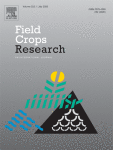Ver ítem
- xmlui.general.dspace_homeCentros Regionales y EEAsCentro Regional Buenos Aires SurEEA BalcarceArtículos científicosxmlui.ArtifactBrowser.ItemViewer.trail
- Inicio
- Centros Regionales y EEAs
- Centro Regional Buenos Aires Sur
- EEA Balcarce
- Artículos científicos
- Ver ítem
Eco-physiological processes underlying maize water use efficiency response to plant density under contrasting water regimes
Resumen
This study quantified maize (Zea mays L.) water use efficiency for grain yield (WUEg) in response to plant density under contrasting water regimes; and focused on relevant eco-physiologial processes underlying the responses of maize WUEg to plant density (i.e., the proportion of transpiration in the total water used, T/ET; and the crop growth rate during the critical period for kernel set, CGRcp). Maize crops were grown at Balcarce, Argentina during two
[ver mas...]
This study quantified maize (Zea mays L.) water use efficiency for grain yield (WUEg) in response to plant density under contrasting water regimes; and focused on relevant eco-physiologial processes underlying the responses of maize WUEg to plant density (i.e., the proportion of transpiration in the total water used, T/ET; and the crop growth rate during the critical period for kernel set, CGRcp). Maize crops were grown at Balcarce, Argentina during two seasons. Treatments included two water regimes (i.e., rainfed and irrigated) and three plant densities (4, 8 and 12 plants m−2). Measurements comprised (i) soil water content and iPAR during the whole growing season, (ii) shoot biomass around silking and (iii) grain yield and shoot biomass at physiological maturity. Crop ET was calculated by means of water balance and soil evaporation was measured with micro-lysimeters. The response of WUEg to increasing plant density from 4 to 8 or from 4 to 12 plants m−2 was influenced by seasonal water supply. Both seasonal ET and T/ET consistently increased with plant densities across contrasting water regimes. Although increments in T/ET partition were in accordance with increasing iPAR, they did not promote higher WUEg at low water supply. Grain yield increased with plant density, except in the driest environment where no response of either grain yield nor WUEg to plant density was detected. Our results showed that the response of CGRcp to plant density increments (i) depended on the water supply, and (ii) contributed to explain WUEg response to plant density under contrasting water supplies.
[Cerrar]

Fuente
Field Crops Research 254 : 107844 (September 2020)
Fecha
2020-09
Editorial
Elsevier
ISSN
0378-4290
Formato
pdf
Tipo de documento
artículo
Palabras Claves
Derechos de acceso
Restringido
 Excepto donde se diga explicitamente, este item se publica bajo la siguiente descripción: Creative Commons Attribution-NonCommercial-ShareAlike 2.5 Unported (CC BY-NC-SA 2.5)
Excepto donde se diga explicitamente, este item se publica bajo la siguiente descripción: Creative Commons Attribution-NonCommercial-ShareAlike 2.5 Unported (CC BY-NC-SA 2.5)

